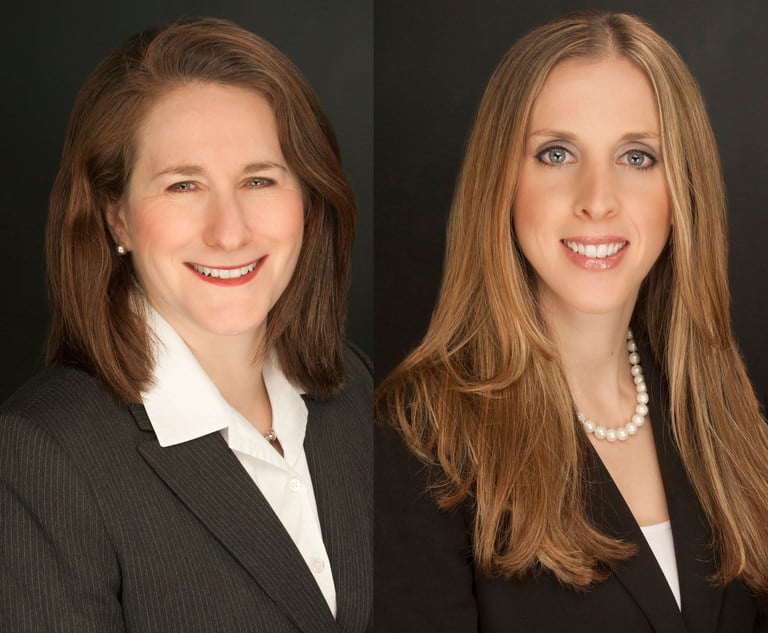 Rebecca Rosenberger Smolen, left, and Amy Neifeld Shkedy, right, of Bala Law Group.
Rebecca Rosenberger Smolen, left, and Amy Neifeld Shkedy, right, of Bala Law Group. Year-End Tax Planning Guidance: Key Issues to Consider Before 2022
Again, we face significant uncertainty for 2022 as there are many proposals on tax increases, but, it's by no means clear that Congress will actually be able to legislate on this front despite the technical majorities that exist favoring the Democratic Party agenda. In this article we will discuss what is slated to be the scenario if the status quo continues, as well as touch on the potential changes if somehow tax legislation actually happens this year.
October 27, 2021 at 01:09 PM
9 minute read
As year-end approaches, now is a good time to focus on addressing tax planning for 2021 before it's too late, and to take stock of the anticipated tax "climate" for next year. When we wrote this column last year, it was before we knew the results for the Biden/Trump election, so, things were very uncertain for 2021. Again, we face significant uncertainty for 2022 as there are many proposals on tax increases, but, it's by no means clear that Congress will actually be able to legislate on this front despite the technical majorities that exist favoring the Democratic Party agenda. In this article we will discuss what is slated to be the scenario if the status quo continues, as well as touch on the potential changes if somehow tax legislation actually happens this year. Here's our list of key issues to consider before Jan. 1, 2022:
|- Annual Exclusion Gifts. Each individual can make a cumulative annual gift tax exclusion gift of $15,000 per donee during 2021, and that amount is expected to increase to $16,000 for 2022 ($30,000 for a married couple electing to split gifts in 2021, or an expected $32,000 in 2022), without using any portion of his or her federal estate and gift tax exemption (discussed below). Annual exclusion gifts can be made outright, through 529 Plan benefits (education savings accounts), or in special qualifying trust structures. For those still considering such gifts, it may be worthwhile to plan for 2021 and 2022 at the same time, keeping in mind that gifts for 2022 can be made effective as of Jan. 1.
- Use of Exemption. For 2021,the federal and gift tax exemption amount is $11.7 million per individual (allowing a married couple to shield up to $23.4 million from federal estate and gift taxes), and is projected to increase for inflation in 2022 to $12.06 million per individual (or $24.12 million for a married couple). There is no guarantee that these exemption amounts will remain at such high levels. In fact, there are current proposals to accelerate the reduction which would happen under current law in 2026, to bring the exemptions to 50% of the current levels (so $6.03 million per individual, and $12.06 million for a married couple). During Biden's candidacy last year, his "moderate" agenda was to bring it down even lower, to $3.5 million per person, so, it's important to be mindful as that as well.
As we explained in our article in the fall 2020, "Will It Be 2012 All Over Again," many high net worth individuals last year were considering whether to make large gifts before year end in order to use their exemptions before the amounts dropped. The same is, of course, true this year for those who didn't already act. This type of planning needs to be carefully thought out and considered well in advance of year end, so that there is not a last minute rush into making irrevocable and potentially irreversible decisions. Moreover, estate planners will need ample time to properly guide clients and draft documents to effectuate a plan. There will also need to be enough time to open accounts at financial institutions in many instances. An added issue this time around, is that there are proposals to close off some significant tax planning opportunities related to "grantor trusts" before year end if a new tax law is actually enacted before Dec. 31.
|- Accelerate Deductions. Prepay deductible expenses due in January (including state and local income tax estimated payments which may not be due until January). However, because of the $5,000 per person cap (i.e., $10,000 for a married couple) for deductions for all state and local taxes, it's important to ascertain whether the limit has been reached before accelerating a payment of such taxes which may be deferred until 2022.
- Loss Harvesting. Harvest tax deductible losses to offset taxable gains for 2021. However, be mindful of the 30 day wash sale rule of Internal Revenue Code Section 1091, which could disqualify a deduction of the capital loss if the same, or substantially identical, security is purchased within 30 days after selling at a loss.
- Required Minimum Distributions. For those who have reached their required beginning date or who hold inherited IRA accounts, be sure to take your required minimum distribution for 2021 from your traditional IRA or qualified plan account by Dec. 31. Note that taxpayers who are 72 or older are able to transfer up to $100,000 from an IRA (other than an inherited IRA) directly to a qualifying charity (a charitable rollover) in partial or full satisfaction of their required minimum distribution for 2021.
- Qualified Retirement Plan Establishment. Business owners who are considering funding a new retirement plan have the opportunity to establish a qualified retirement plan by the end of the year but defer the decision about the funding amount (and the actual contribution) until later during 2022 (contributions can generally be delayed until at least Sept. 15). The limitation for tax deductible contributions for 2021 is $58,000 per participant for defined contribution plans (or up to $64,500 when including the $6,500 catch-up contribution for a participant who has reached the age of 50). Next year this cap is projected to be increased to $61,000 (or $67,500 when including the $6,500 catch-up for 2022).
- Roth IRA Conversion. Convert a traditional IRA to a Roth IRA to take advantage of lower brackets or absorb excess deductions. By converting a traditional IRA to a Roth IRA, any untaxed amounts that are rolled over to the Roth IRA are subject to income taxation. The conversion must take place by Dec. 31. Under current law, Roth IRA conversions can no longer be reversed. Before 2018, under prior law, you had until Oct. 15 of the year after conversion to reverse it by re-characterizing the conversion back to a traditional IRA to avoid the tax hit. It's important to be mindful that the tax proposals being considered in Congress include higher tax rates for higher income individuals, as well as the imposition of AGI limitations on the ability of a taxpayer to qualify for a conversion, so, special attention should be paid to this powerful tax planning option in 2021, before it may be eliminated for many folks in the future.
- Basis Step-Up Planning. For individuals who have funded "grantor" trusts for their families, year-end is a good time to consider swapping back low basis assets (e.g., appreciated stock) for high basis assets (e.g., cash) to help make tax reporting after the swap cleaner (rather than switch tax identification numbers in the middle of a tax year). It's better to own the lower basis assets at death because of the opportunity for a basis step-up to fair market value under Internal Revenue Code Section 1014. This could change in the future if the step-up basis at death is eliminated as Biden had earlier proposed, but, that change is not included in current pending legislation in Congress. There is a possible change in how grantor trusts are treated for tax purposes in multi-faceted ways, which is proposed to go into effect before year end, if the date of enactment is before Dec. 31 as the legislation is currently drafted, so, stay tuned.
- Charitable Giving. If you are in a high income year, consider "prepaying" future charitable contributions to generate current income tax deductions. This is also something to consider given the new higher standard deduction (for 2021, $12,550 for individuals and $25,100 for married couples) that might make bunching of charitable deductions worthwhile so you can benefit from the standard deduction in a year where your charitable deductions are reduced due to the prior year bunching/prepayment. This can be accomplished simply by increasing the contributions to your favorite charities, in general, or you can defer the receipt by the charitable organizations you wish to benefit (or even defer the decision as to which ones to benefit) by contributing to a donor advised fund, a private foundation, charitable lead trust or charitable remainder trust or purchasing a charitable gift annuity. Both the charitable gift annuity and charitable remainder trust options allow you to retain an income stream for life and defer the transfer of the remaining funds to the charity until after your death.
- IRAs and HSAs. While you technically have until April 15, 2022, to fund your Individual Retirement Account and Health Savings Account for 2021, it is always a good idea to start planning for such funding at year end. Consider helping your children (to the extent that they have earned income) to fund tax favored Roth IRAs if at all possible. The maximum contributions for IRAs for 2021 is $6,000 and is projected to stay the same in 2022 (plus an extra $1,000 catch up for those who have reached the age of 50). The maximum family contribution for an HSA in 2021 is $7,200 (or $3,600 for individuals), with an extra $1,000 available for those who have reached the age of 55. For 2022, the maximum family contribution for an HSA will increase to $7,300 (or $3,650 for individuals).
- Trust Income Tax Planning. While a trustee will generally have until 65 days after the end of the tax year to shift trust taxable income to a beneficiary, it's worthwhile to monitor the issue at year end to get a jump start on evaluating the issue. This has become a more consequential issue with the Medicare tax imposed at 3.8% and the extra 5% tax imposed on dividends and capital gains at the higher brackets (which are reached pretty quickly for a trust).
- Estate Plan Review. Last, but not least, although not necessarily year-end sensitive, the end of the year is a great time to review your estate plan (or make a resolution to review in 2022) to see if changes might be in order (whether because of changes in the tax law, your wealth, your chosen fiduciaries, or objects of your bounty). Because technically it's the last deadline on everyone's list, it's helpful to create (and stick to) artificial deadlines to make appropriate adjustments before it becomes too late to do so.
Rebecca Rosenberger Smolen and Amy Neifeld Shkedy are members and co-founders of Bala Law Group. They focus their practices on tax and estate planning.
This content has been archived. It is available through our partners, LexisNexis® and Bloomberg Law.
To view this content, please continue to their sites.
Not a Lexis Subscriber?
Subscribe Now
Not a Bloomberg Law Subscriber?
Subscribe Now
NOT FOR REPRINT
© 2025 ALM Global, LLC, All Rights Reserved. Request academic re-use from www.copyright.com. All other uses, submit a request to [email protected]. For more information visit Asset & Logo Licensing.
You Might Like
View All
Former Perkins Coie Partner Moves to Stradley Ronon in Chicago

Proskauer Rose Investment Management Trio Jumps to Stradley Ronon


Stradley Ronon Bolsters Investment Management Practice With Vanguard Hire
4 minute readTrending Stories
- 1Special Series Part 2: CT Constitution’s Text Does Not Authorize the Statutory Guardrails
- 2Initial Steps to Set Up a Fla. Appeal: Your Future Self (or Appellate Attorney) Will Thank You
- 3Bar Report - Jan. 6
- 4New York’s Property Tax Incentives and Abatements Make Development Feasible
- 5Legal Tech's Predictions for Artificial Intelligence in 2025
Who Got The Work
Michael G. Bongiorno, Andrew Scott Dulberg and Elizabeth E. Driscoll from Wilmer Cutler Pickering Hale and Dorr have stepped in to represent Symbotic Inc., an A.I.-enabled technology platform that focuses on increasing supply chain efficiency, and other defendants in a pending shareholder derivative lawsuit. The case, filed Oct. 2 in Massachusetts District Court by the Brown Law Firm on behalf of Stephen Austen, accuses certain officers and directors of misleading investors in regard to Symbotic's potential for margin growth by failing to disclose that the company was not equipped to timely deploy its systems or manage expenses through project delays. The case, assigned to U.S. District Judge Nathaniel M. Gorton, is 1:24-cv-12522, Austen v. Cohen et al.
Who Got The Work
Edmund Polubinski and Marie Killmond of Davis Polk & Wardwell have entered appearances for data platform software development company MongoDB and other defendants in a pending shareholder derivative lawsuit. The action, filed Oct. 7 in New York Southern District Court by the Brown Law Firm, accuses the company's directors and/or officers of falsely expressing confidence in the company’s restructuring of its sales incentive plan and downplaying the severity of decreases in its upfront commitments. The case is 1:24-cv-07594, Roy v. Ittycheria et al.
Who Got The Work
Amy O. Bruchs and Kurt F. Ellison of Michael Best & Friedrich have entered appearances for Epic Systems Corp. in a pending employment discrimination lawsuit. The suit was filed Sept. 7 in Wisconsin Western District Court by Levine Eisberner LLC and Siri & Glimstad on behalf of a project manager who claims that he was wrongfully terminated after applying for a religious exemption to the defendant's COVID-19 vaccine mandate. The case, assigned to U.S. Magistrate Judge Anita Marie Boor, is 3:24-cv-00630, Secker, Nathan v. Epic Systems Corporation.
Who Got The Work
David X. Sullivan, Thomas J. Finn and Gregory A. Hall from McCarter & English have entered appearances for Sunrun Installation Services in a pending civil rights lawsuit. The complaint was filed Sept. 4 in Connecticut District Court by attorney Robert M. Berke on behalf of former employee George Edward Steins, who was arrested and charged with employing an unregistered home improvement salesperson. The complaint alleges that had Sunrun informed the Connecticut Department of Consumer Protection that the plaintiff's employment had ended in 2017 and that he no longer held Sunrun's home improvement contractor license, he would not have been hit with charges, which were dismissed in May 2024. The case, assigned to U.S. District Judge Jeffrey A. Meyer, is 3:24-cv-01423, Steins v. Sunrun, Inc. et al.
Who Got The Work
Greenberg Traurig shareholder Joshua L. Raskin has entered an appearance for boohoo.com UK Ltd. in a pending patent infringement lawsuit. The suit, filed Sept. 3 in Texas Eastern District Court by Rozier Hardt McDonough on behalf of Alto Dynamics, asserts five patents related to an online shopping platform. The case, assigned to U.S. District Judge Rodney Gilstrap, is 2:24-cv-00719, Alto Dynamics, LLC v. boohoo.com UK Limited.
Featured Firms
Law Offices of Gary Martin Hays & Associates, P.C.
(470) 294-1674
Law Offices of Mark E. Salomone
(857) 444-6468
Smith & Hassler
(713) 739-1250





